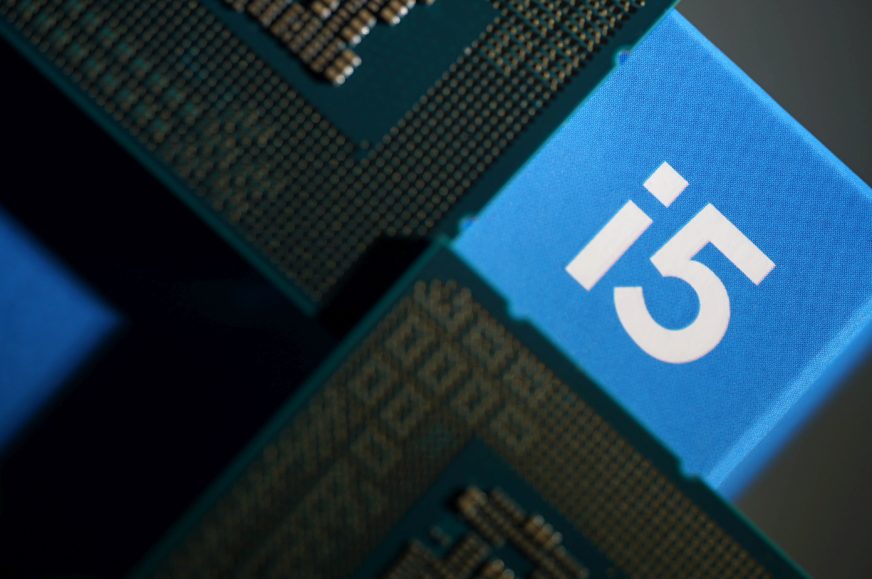Leaked marketing slides bring new info on 13th generation Intel Core desktop processors
Yesterday we reported that Raptor Lake processors are largely a continuation of the Alder Lake generation using the same ingredients, despite a large increase in achieved clock speeds and some architectural changes (cache). This is even more true than we thought. It turns out that only the higher-tier K-series models are actually new chips. The lower end, including all 65W Core i5s, are recycling silicon from the Alder Lake generation.
Further information on Raptor Lake has emerged from a partly official, partly unofficial source. The igor’sLAB website has published marketing slides for the processors, which, although leaked, almost certainly come directly from Intel (the layout looks right and it’s 26 pages, which hardly anyone would want to fake). These documents bring confirmation of the specs of the 125W models that will be the first to be released (as early as next month, expect the other 65W models after the new year), this time finally including a figure for maximum turbo power draw, aka PL2.
Maximum turbo power draw revealed
This actual (as opposed to the claimed TDP) power limit indicates how many watts the processor can draw in boost (which is however something that is always active) under multi-threaded loads. The 125W processor specification table included in the slides has finally revealed PL2 for all of these models. In the end, it’s 253 W for both the Core i7-13700K/KF and Core i9-13900K/KF models with eight large P-Cores (and either 8 or 16 E-Cores). Which means that this leak has been confirmed.
Only the Core i5-13600K (and i5-13600KF) SKUs with six P-Cores and eight E-Cores have a smaller maximum, their PL2 is “only” 181 W.
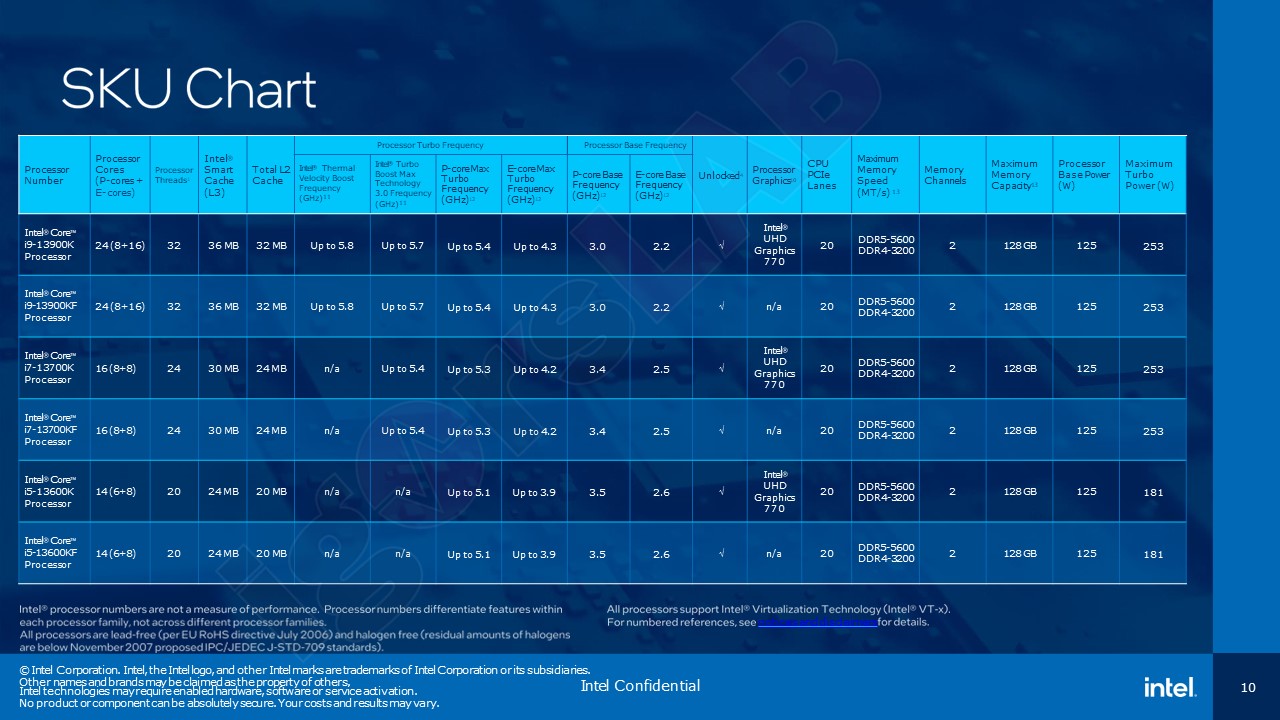
It’s worth adding that motherboards can unlock the PL2 limit to allow the processor to reach higher boost clock speeds. In such case the power draw will be higher. Intel is also said to be offering a special extreme mode with Core i9 on selected new boards that will increase the limit to 350 W. However, this will probably be explicitly presented as a user overclocking.
Tip: Intel Raptor Lake power draw: Core i9s are said to have an extreme 350W mode
Core i5 (excluding K/KF models) and Core i3 are rebranded Alder Lake
The full slide set can be viewed directly at Igor’s. Perhaps the most interesting thing can be found in one small, perhaps not so obvious, note. As an advantage of the Raptor Lake processors, Intel mentions that they have an increased L2 cache for large cores (1.25 MB to 2 MB) and an increased shared L2 cache for the small E-Core clusters (2 MB to 4 MB). These are apparently exactly those cache changes to improve gaming performance that the leaked documents has been talking about for a long time, with regard to Raptor Lake.
But wait a moment: Intel’s note on this states that the increased L2 cache only applies to some processors – Core i9, Core i7 and 125W Core i5 models. The exact wording is “Core i5K and higher models”. Lower processors (Core i3 and regular 65W Core i5 models) are not getting these larger caches.
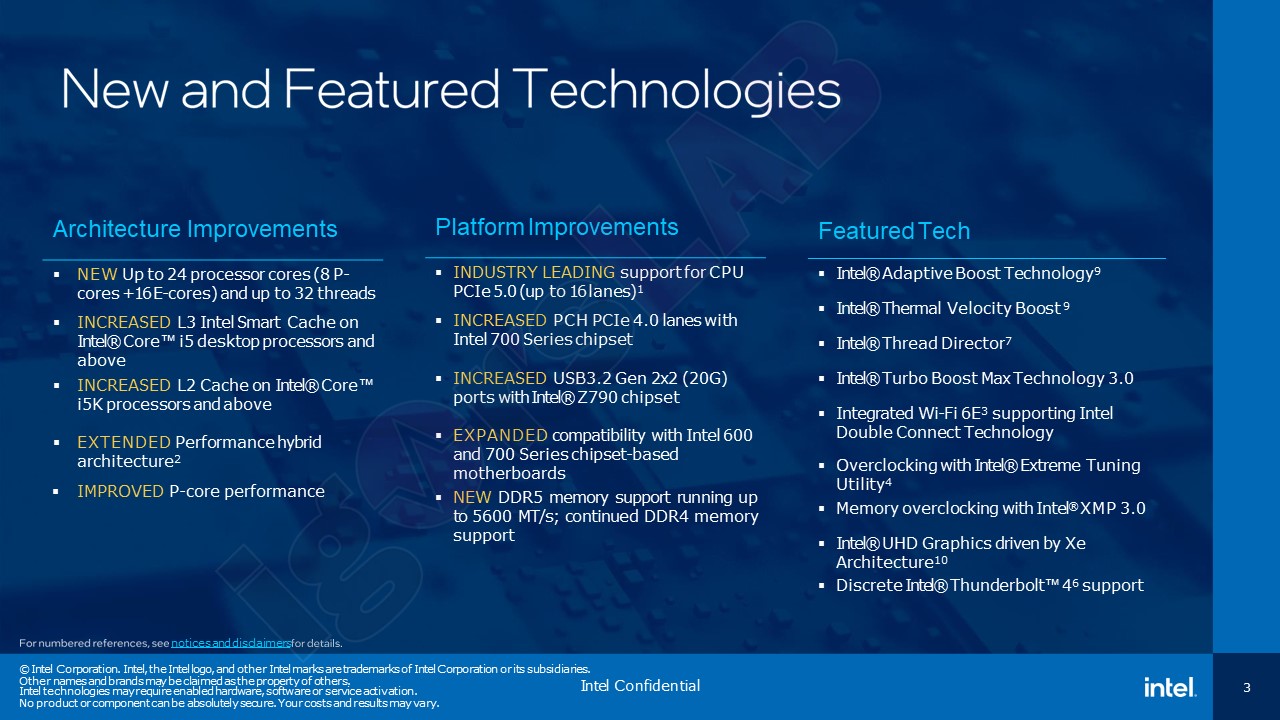
Why? Apparently we already have the answer. Some time ago, there was speculation that Intel would not build these cheaper processors on the new Raptor Lake silicon. It seems that there is just a single new die, that is the large chip with 8+16 cores, which the internal designation B-0. Cheaper models will be based on silicon designated C-0 (65W Core i5) and H-0 (Core i3). These designations are the same as for the silicon used in the Alder Lake generation (those have 8+8 cores and 6+0 cores), which has immediately raised suspicions that these processors would not be Raptor Lake, but basically rebranded Alder Lake.
The slide from igor’sLAB, which now proves that these models “coincidentally” have the old L2 cache size, seems to conclusively confirm that this theory has hit the mark. Those C-0 and H-0 chips are indeed apparently the original silicon used in the Alder Lake generation. Besides the fact that these dies will lack the larger L2 cache, they may also have an impact in the fact that only DDR5-4800 memory speeds will be officially supported for such processors, instead of DDR5-5600 on the new Raptor Lake B-0 die. This aslo means these models probably can’t be expected to have a higher OC potential (when overclocking via BCLK is used) than the corresponding Core 12th generation models.
Read more: Locked 65W Alder Lake processors can be overclocked. Over 5.2 GHz BCLK on Core i5-12400
So Intel will be making 65W 13th generation Core i5 processors (which will have 6+8 or 6+4 cores) from Alder Lake silicon with 8+8 cores, and the 13th generation Core i3 (which still have only four large cores and no small ones) will be made from a smaller version with 6+0 cores. So all of these models will end up with two large cores physically present but disabled. This will help with absorbing bad bins or defective dies from Alder Lake production, but in time, Intel will probably have to use a lot of chips that had all eight P-Core functional (but will still be disabled). This is not optimal from a unit manufacturing cost perspective, but it’s probably more worthwhile than designing entirely new chips, which would in turn incur an extra fixed cost.
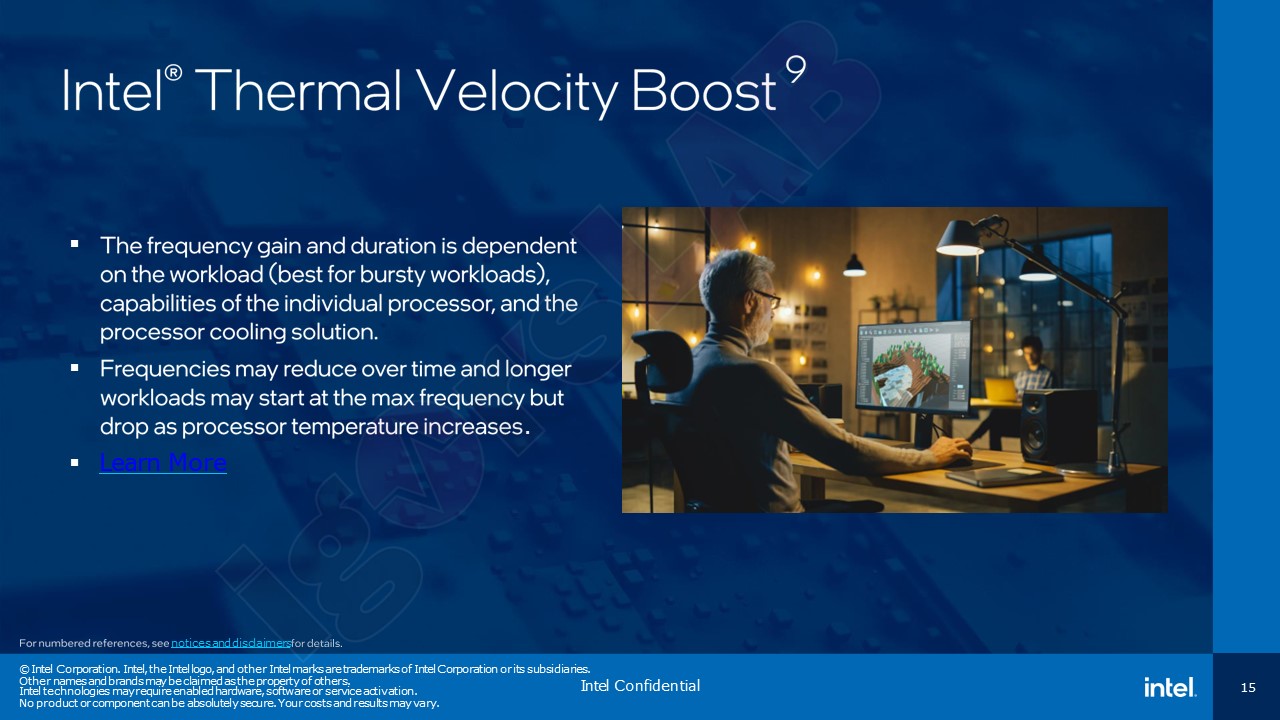
Thermal Velocity Boost threshold should be 70 °C again
Another detail that the slides clarified is the Thermal Velocity Boost. This increases the boost of Core i9 processors by 100 MHz if the temperature is below a certain limit (note: this extra is already included in the stated maximum boost). For example, the Core i9-13900K has a maximum boost of 5.7 GHz on its preferred cores, but can go up to 5.8 GHz if the temperature is not over the limit. Until now, we didn’t know where this threshold (or perhaps ceiling) temperature would be for Raptor Lake. According to igor’sLAB’s slides, the answer is 70 °C. This is the same as previous generations. However, it’s also possible that not all boards will respect this, deviating or outright not using any threshold at all.
Twenty PCIe 4.0 lanes from the Z790 chipset
Finally, there is one thing that will please some demanding users who require extensive connectivity. Igor’sLAB also showed the specifications and connectivity diagrams of the Z790 chipset, which will now be coming in the new Raptor Lake boards. On the one hand, it was once again confirmed that the Raptor Lake processor itself still only has 16 PCI Express 5.0 lanes for the GPU, its additional interface for direct SSD connection to the processor is just PCIe 4.0×4 like with Alder Lake.
But the chipset connected to the CPU via DMI4×8 (equivalent to PCIe 4.0×8) will have much improved capabilities. The Z690 chipset provided 16 PCIe 3.0 lanes and 12 PCIe 4.0 lanes. But with the Z790, Intel has promoted additional lanes to higher speed, so there will only be eight of those 3.0 lanes, but in exchange the chipset now has 20 PCIe 4.0 lanes. These can be distributed to PCI Express and M.2 slots on the board for SSDs, which will allow for some pretty generous expansion options with perhaps two or even three PCIe 4.0 ×4 card slots.
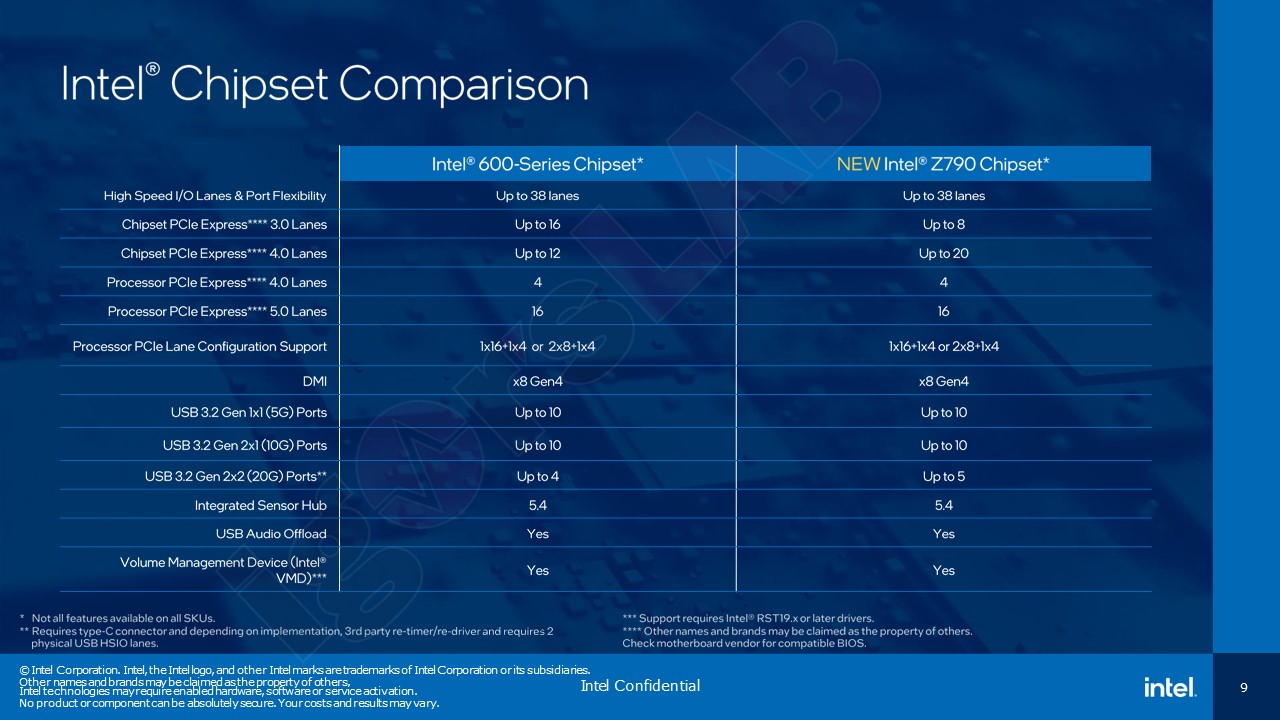
But it will of course be up to the board manufacturers to take advantage of these opportunities. The gamer-oriented boards don’t really care about expansion slots nowadays, because at least two and usually even three slots under the graphics card are not used by gaming PCs anyway. AMD X670 and X670E platform boards, for example, usually have only two or three card slots. We assume it could be similar for the Z790 gaming boards (but they could in turn have, say, five M.2 slots with PCIe 4.0×4). But hopefully there will be some “Workstation” and “Creator” boards that have more slots for cards.

Another improvement of the Z790 chipset is that it supports up to five 20Gbps SuperSpeed USB ports (USB 3.2 Gen 2×2). However, the Z690 already supported four, which is probably more than enough for most uses; the vast majority of boards probably won’t realistically make that many 20Gbps ports available.
Source: igor’sLAB
English translation and edit by Jozef Dudáš
⠀





